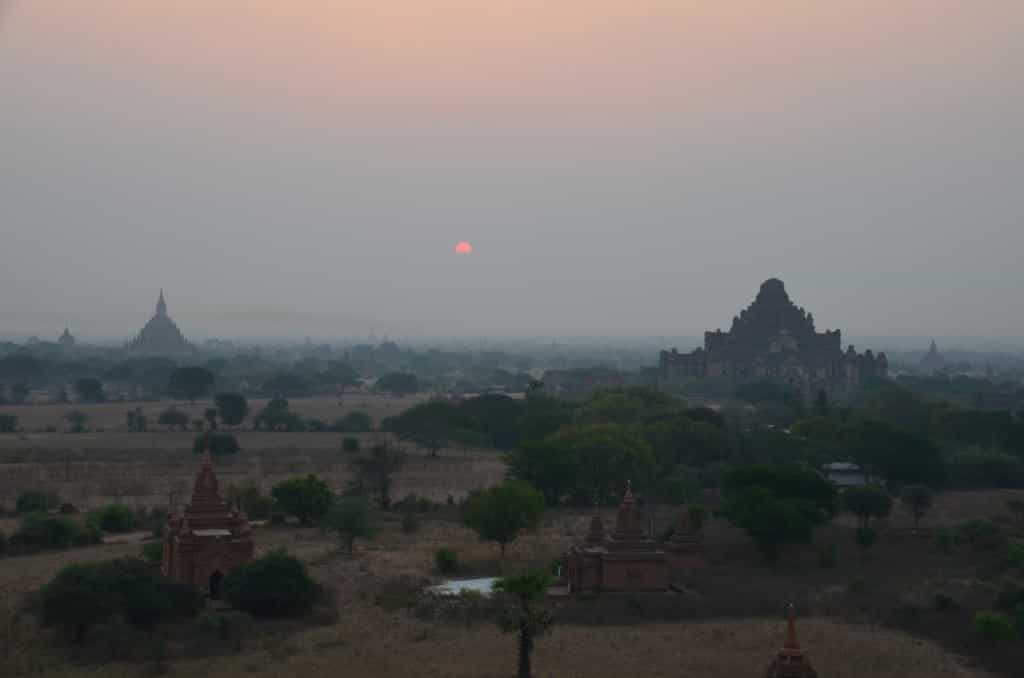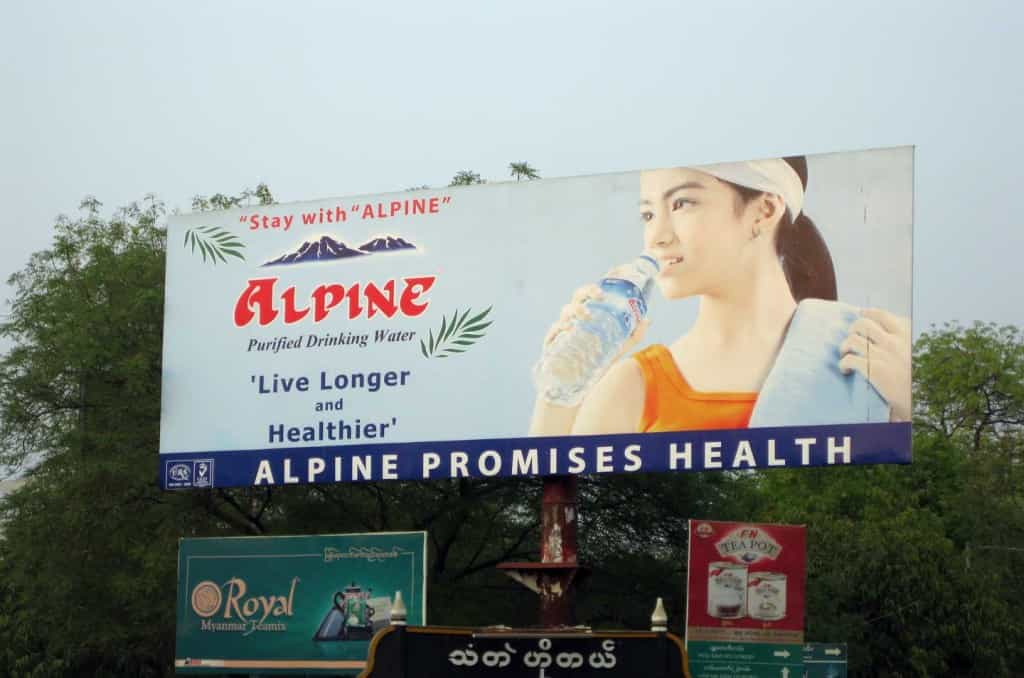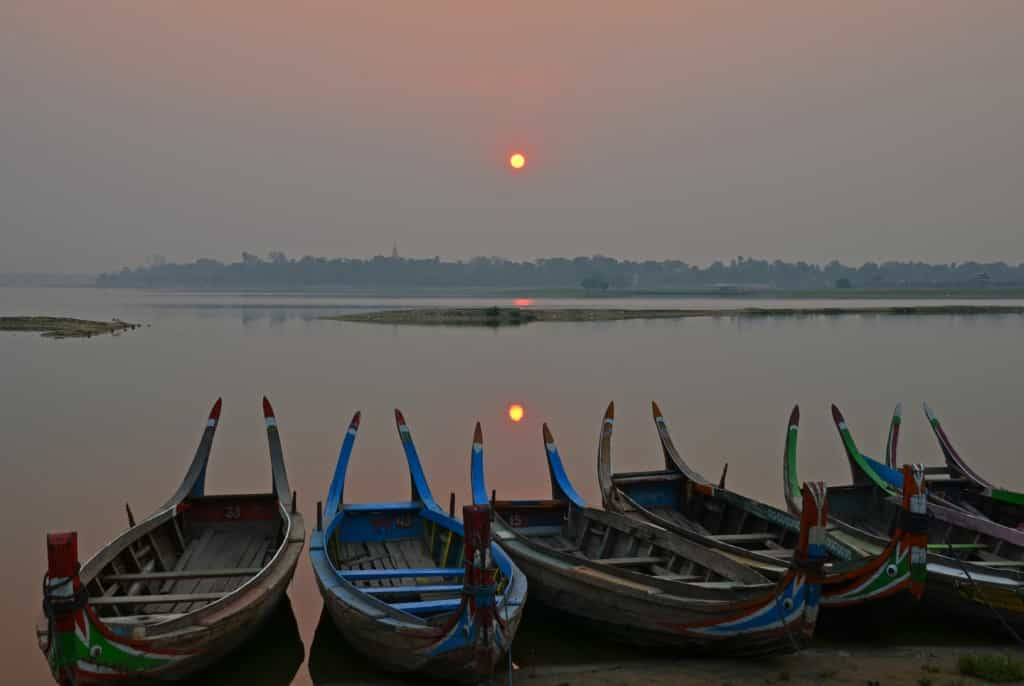The Kings who ruled over old Bagan spent a couple of centuries in a furious spree of construction, building over 4,000 temples in the area. I couldn’t help but think of the video game series Civilization, where one controls the development of a civilization from the Stone Age to some time in a distant future.
– So, the Burmese built what for 230 years? Temples.
– What were the Mongols building at the time? Armies.
No need for a history book to figure out what happened next. The Mongols wiped them out in 1287.
If you look closely at the Sun, you see it seems to be just rising, in the middle of the morning sky. The fact is that the air is so thick with smoke and dust, that along the horizon, its light cannot make it through. It become visible at around 10 degrees of elevation. As I hinted in my last post, Myanmar was not the best travel destination, for me, at that time. Bagan is an incredible and popular area for temple watching, but my interest in temples at that time was sorely lacking.
I still went around, climbing to hard to reach temples, like this one on Mount Popa (the hard part about this one was not the climb, it was the hour long pick-up ride, trying not to die from the mild carbon monoxide poisoning we were all getting).
And walking around beautiful temples, like the Shwe Zigon Paya. On a technical note, this was during a short bike ride and I wasn’t carrying my big camera. Sometimes I’m shocked at what comes out of my little point-and-shoot Canon camera, especially in difficult, intense back-lit conditions. I think this shot is pretty cool and it reminded me of this one, in Swakopmund, Namibia, also with the little camera.
Better than any temple, I discovered the Fountain of Youth. This water I knew nothing of promises health. It sounds extraordinary, but for the claim to make it on a billboard, it undoubtedly underwent extensive clinical trials which were thoroughly reviewed by the Government of Myanmar.
After flying from Heho to Mandalay, I booked a motorbike taxi for a day and took off around 5h45 in the morning. I made it to U Bein’s bridge, the longest teak bridge in the World, at almost 1.2 km. Supported by 1060 wood poles (and a few concrete ones), it sees an impressive amount of foot traffic, although there were mostly monks when I arrived, before sunrise.
As in Bagan, the Sun strives to make through the thick air and only becomes visible significantly above the horizon. While lacking in contrast, this picture gives you an idea of the impressive length of the bridge (if you click on it).
As I mentioned in my previous post, you can’t “go local” with Myanmar accommodation. You are restricted to establishments authorized to host foreign tourists. However, on the food side you can do whatever you want. Since there were essentially no tourists around at this time of the day, I went where the locals seemed to be having breakfast, and pointed a lot. Fried food is very popular, so I indulged. I had a long doughnut type bread (twice as long as in the picture – before I ate half), served with some white beans, two vegetable samosas (one already eaten), served with herbs, hot peppers and a coffee. Later, I stopped at another local joint and had another coffee. So far that day, I had yet to spend a dollar.
The pre-dawn bridge visit was done by renting a motorbike taxi. Not a habit of mine but, surprisingly, I couldn’t find people to share a car taxi with and I was too cheap to hire one by myself for the day. After breakfast, we stopped in the village of Paleik, to visit a temple where a few pythons showed up some years ago, and were adopted by the locals, perhaps seeing an omen of sorts. People go and take pictures of themselves with the snakes after their 11 am daily bath. It was 10 o’clock when I visited and I saw them coiled in a corner. I would have waited for the daily bath, but my driver informed me that the monster you see in the picture had, sadly, died less than two weeks ago. The other two snakes were too small for me to want to wait an hour.
WARNING: Investment babble for the next 5 paragraphs.
The next stop along the “normal” itinerary was the temples of whatever, but I wasn’t interested. Since my motorbike driver spoke better English than many so-called guides I had in Myanmar, I decided to try and learn a few things. As it turns out, I got a lesson in the power of capital in countries with no access to credit. Not a major academic surprise, of course, but interesting to put a face and numbers on the problem.
My driver does not own the motorbike. I think he used to own a rickshaw, but that business has been disappearing. So, he rents a motorbike for 3500 Kyat per day ($4). He also pays the gas and minor repairs. I gave him about $20 for what turned out to be less than the agreed day, simply because I wanted to do something else after a while. So, a good day for him, as he may have had other clients, but when he doesn’t get a single client, he’s short $4. Doubtless a tough job, but that’s not my point.
He told me a Chinese scooter like his sold for $400 (I checked, that’s for very low end models, but since his looked like garbage, I’ll buy the figure). This is an amount he can hardly come up with because he lives day to day and supports his siblings in school. This means that even after management costs and periodic major maintenance, the owner can recoup his investment in a matter of 4 months, at most (excluding possible corruption, licensing or other costs I am not aware of). So, were I to buy a hundred scooters for $40,000 and rent them, within a few months I would have a gross income of $400 a day! Too bad I don’t want to live in Myanmar. Let’s run numbers for fun and be very conservative.
Cost of 100 scooters: $40,000
Life cycle of scooters: 4 years
Rental income over life cycle: $584,000 ($4 x 365 days x 4 years x 100 scooters)
Minus management (10%), maintenance (10%), “vacancy” (10%), corruption (10%): $350,000
Minus initial investment: $310,000
Annual rate of return: 194%
Buy better, $800 scooters, and double expenses to a staggering 80% of gross, and you still have a return of nearly 40%. So, why isn’t everyone doing it? Because coming up with $40,000 is inconceivable for almost everyone in the underdeveloped world. And that’s why the few who can, are rich.
WARNING: End of investment babble
Craving change, I went to the Diamond Plaza, Mandalay’s largest, and I think only modern, western style shopping centre. It is well designed, although obviously built for low cost rather than spectacular architecture. Unfortunately, it is very depressing at the moment, as they just opened, but with at most a third of the retail space rented, and several floors look like that picture. I looked for a food court, eventually finding a few restaurants, strangely, on the top floor. There was also a movie theatre, so I decided to go see “The Life of Pi”, which I had been meaning to see for a while.
I inquired about the language and was surprised to learn that it was in English, with no subtitles. Since the English skills of most people in Myanmar are far from great, I was surprised they would go watch such a movie in English. As I quickly realized, they mostly go to look at the pictures, while they talk amongst themselves – and on their cell phones – for the entire movie. Luckily, there was no one right next to me. In fact, since they sell numbered seats and the price depends on the quality, I watched the movie by myself, in the middle of row 6 or 8, with a hundred or so locals filling the seats in the very front, back and sides. Of course, I paid $3, while they got in for $1.50.
After the movie, I hoped to recover from air-conditioning induced hypothermia by eating a nice hot Thai soup at the restaurant across from the cinema (nothing I could do about the hearing loss, it was permanent 5 minutes after the start of the movie). The restaurant was a strange affair, with crazy decorations and giant screen televisions blasting music videos (each a different one, of course). But, it was busy with locals and I must say the soup was awesome.
Since I was the only foreigner in the place (probably in the whole mall), I attracted some attention. Next to me, there was a little birthday party involving half a dozen girls (three missing from the picture). They decided I should have a piece of cake. I’m sorry the flash killed the cake. I ate it and it was funny, until they thought I should have another piece, and one of them was going to feed it to me! I imagined the scene where I’m trying to explain what’s going on to the dad/brother who just walked in… and I stopped the fun right there.
All and all, a good time in Myanmar. On a safety note, as I was writing this, my friend Karine inquired about my safety, as 20 people had been killed in inter-religious riots, and she didn’t know if I was already out of the country. Myanmar allows independent tourism (you don’t have to go with a tour group, unlike Bhutan or North Korea). However, they do restrict where you can sleep and where you can go. If you are an NGO/journalist type, perhaps there is some sinister design behind this, I don’t know. But, for the normal tourist, the Government is just trying to keep you from entering the areas where ethnic or religious tensions are ongoing, to keep you from getting killed and hurting the country’s image and tourism industry. That’s why the restricted and allowed areas keep changing. So, don’t let the riots scare you away.
#Myanmar












Pingback: Tibet, part 1: Monasteries, temples and other boring things. | Colin’s Notes